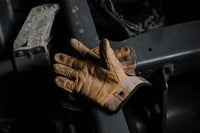The first thing that comes to mind when you need wrought iron repaired is welding. That’s the usual way to fix broken or cracked iron, but sometimes welding just isn’t an option. Maybe you don’t have access to the tools, maybe the piece can’t be moved, or maybe it’s just not worth the cost for a small fix.
That’s why I put together this step-by-step guide. It walks you through a few practical ways to repair damaged wrought iron without welding. Whether it’s a crack, a loose piece, or a rusty spot, there’s likely a fix that works for your situation.
1. Assess the Damage
Identify the issue
Start by looking closely at the damage. Is it a clean break, a crack, or just surface rust? Cracks might look like thin lines but can spread over time. A full break means the piece is completely separated and may need more support. Rust damage can eat through the surface and weaken the metal, especially if it’s been there a while. Knowing exactly what you’re dealing with will help you choose the right repair method.
Evaluate structural integrity
Once you know what kind of damage you're dealing with, take a moment to check if the piece is still strong enough to fix. If it’s something like a small decorative scroll, it’s probably fine to repair. But if the damage is on a load-bearing part like a railing or gate hinge, and it feels loose or bends easily, it might not be safe to patch up. In that case, replacing the part or calling in a professional could be a better option.
2. Clean the Area
Remove rust and debris
A wire brush is great for light rust and loose debris. Use a handheld one with stiff bristles or attach a wire wheel to a drill if you need more power. For smoother areas or finishing touches, medium to coarse grit sandpaper works well. Start with 80 grit and go finer if needed. If the rust is heavy or deep, a small angle grinder with a flap disc or wire cup attachment will save you time. Just make sure to wear safety glasses and work slowly so you don’t remove too much metal.
Ensure a clean surface
A clean surface is important because it helps your repair material stick properly. Whether you’re using epoxy or fasteners, any rust, dust, or paint left behind can weaken the bond. Cleaning also helps you see the full extent of the damage, so you don’t miss any problem spots.
3. Choose a Repair Method
Epoxy Adhesives
Select appropriate epoxy
When picking an epoxy, make sure it’s made for metal repairs. Products like JB Weld are a good choice because they’re strong, heat-resistant, and made to bond well with iron and steel. You want something that can handle pressure and outdoor conditions if needed. Always read the instructions on the package, that’s the most important part. If you’re not sure what to get, don’t guess, ask at your local hardware store or metal workshop. They’ll usually know what works best for the type of repair you’re doing.
Application:
-
Follow the mixing instructions on the package carefully: Get the ratio right and mix it well so it sets properly.
-
Apply to the damaged area: After mixing the epoxy according to the instructions, use a disposable spatula or a small brush to apply it. First, spread a thin, even layer on the clean, dry surface. Press the broken or cracked parts together firmly, then apply another layer over the seam if needed to fill gaps.
-
Clamp or hold the pieces together: They keep everything in the right position while the epoxy sets. It also helps the adhesive bond more tightly, which makes the repair stronger and longer-lasting.
Curing time
Every epoxy has its own curing time, and it’s always listed on the label. Some set in a few minutes, while others need hours or even overnight. Don’t rush this step; let the epoxy cure fully before you move or stress the repaired piece.
Mechanical Fasteners
Mechanical fasteners are things like screws, bolts, or metal brackets used to hold two pieces of metal together. They don’t rely on glue or welding, instead, they work by physically securing the parts in place.
How to Install
You place the bracket over the damaged area, then drill holes and secure it with screws or bolts. This holds the pieces together and adds extra strength, especially in spots that take a lot of pressure or weight. Brackets are easy to find, come in different sizes, and can often be painted to match the rest of the piece.
Consider reinforcement
For a stronger and longer-lasting repair, you can use both epoxy and mechanical fasteners together. This works well when the broken piece needs extra support, like on a railing joint or a gate hinge where there’s regular movement or weight. First, apply the epoxy to bond the surfaces, then secure a bracket or plate over the area with screws or bolts. The epoxy holds everything tightly in place, while the fasteners add structural backup.
Metal Stitching (for Cast Iron)
I added this method for cast iron too, because some of your wrought iron pieces might have cast iron elements, and metal stitching is a preferred method for that - it doesn’t involve heat, which helps avoid cracking or further damage to brittle cast iron:
-
Drill holes along the crack: To start metal stitching, you’ll need to drill a series of small holes along the crack, spaced evenly on both sides. Use a power drill with a metal drill bit. Cobalt or titanium-coated bits work well for cast iron. Make sure the drill is steady and at the right angle so the holes line up properly. You’ll also need a punch to mark the hole spots, a ruler or measuring tape for spacing, and safety gear like goggles and gloves.
-
Insert metal keys or pins: After drilling the holes along the crack, the next step is to insert metal stitching pins, also known as metal keys. These are specially designed fasteners that, when screwed into the tapped holes, pull the sides of the crack together, restoring the structural integrity of the cast iron without the need for welding.
-
When selecting stitching pins, it's important to choose the appropriate size and type for your specific repair. For instance, C1 pins are suitable for thin sections down to 0.100 inches, while C2F and C3 pins are designed for thicker sections. These pins can be purchased from specialized suppliers like Lock-N-Stitch, which offers a range of pins and related tools.
-
To install the pins, you'll need to tap the drilled holes using a tap that matches the thread size of your chosen pins. After tapping, screw the pins into place, ensuring they are flush with or slightly below the surface. This process effectively bridges the crack, providing a durable and long-lasting repair.
-
Seal and finish: Once the stitching pins are in place, the final step is to smooth and seal the area. Start by using a metal file or an angle grinder with a flap disc to grind down any raised parts so the surface is flush. Work slowly and evenly to avoid damaging the surrounding metal. After the surface is smooth, wipe it clean to remove dust and debris.
If the piece will be exposed to moisture or outdoor conditions, it’s a good idea to apply a sealant. A rust-inhibiting primer or metal epoxy coating works well. For extra protection, follow up with a layer of outdoor-grade paint. This helps prevent rust from forming again and keeps the repair looking clean.
4. Finishing Touches
Smooth the surface
It doesn’t matter if you used epoxy or metal elements—you can’t skip this step. Once everything is set and secure, go back and clean up the repair. If you used epoxy, trim or scrape off any extra that might have squeezed out during clamping. A utility knife or a file works well for this once it’s hardened. For metal brackets or stitching pins, use a metal file or a grinder to smooth the surface so it blends in with the rest of the piece. Finish off with some sandpaper to even everything out and remove any sharp edges.
Paint or seal
After smoothing the repaired area, it’s important to protect it with the right paint or sealant. If you used epoxy, go for a paint that’s made for metal and can handle outdoor conditions—something like an oil-based enamel or a rust-resistant spray paint works well. Just make sure the epoxy is fully cured before painting over it.
For repairs done with brackets, apply a rust-inhibiting primer first, then follow up with a metal paint in the color of your choice. If you don’t plan to paint, at least use a clear rust-protective sealant to keep moisture out.
Conclusion
This article has everything you need to repair your wrought iron without the hassle of welding or the cost of hiring a professional. Just follow the steps, take your time with prep, and you’ll have it fixed in no time.
Need help with your wrought iron repair? Contact us for personalized guidance or to get your project done right. Explore our handrails collection to see high-quality options for your next project!









